Welcome to the Ontario Parks “Eyes on the Skies” series. This “space” will cover a wide range of astronomy topics with a focus on what can be seen from the pristine skies found in our provincial parks.
The cold, crisp days of the New Year often reward us with fantastically beautiful nights, rich with bright stars and interesting sights.
Of the 17 brightest stars seen from Ontario, nine are visible during winter nights, and many interesting objects await the observer who is prepared to brave the cold.
Here are our astronomical highlights for January 2025:
The sun
Many people believe that on the Winter Solstice (usually around December 21) we experience the earliest sunset and latest sunrise.
However, while the Winter Solstice marks the sun’s lowest point in the sky at solar noon, the earliest sunset always occurs earlier in the month. Similarly, the latest sunrise usually occurs in early January.
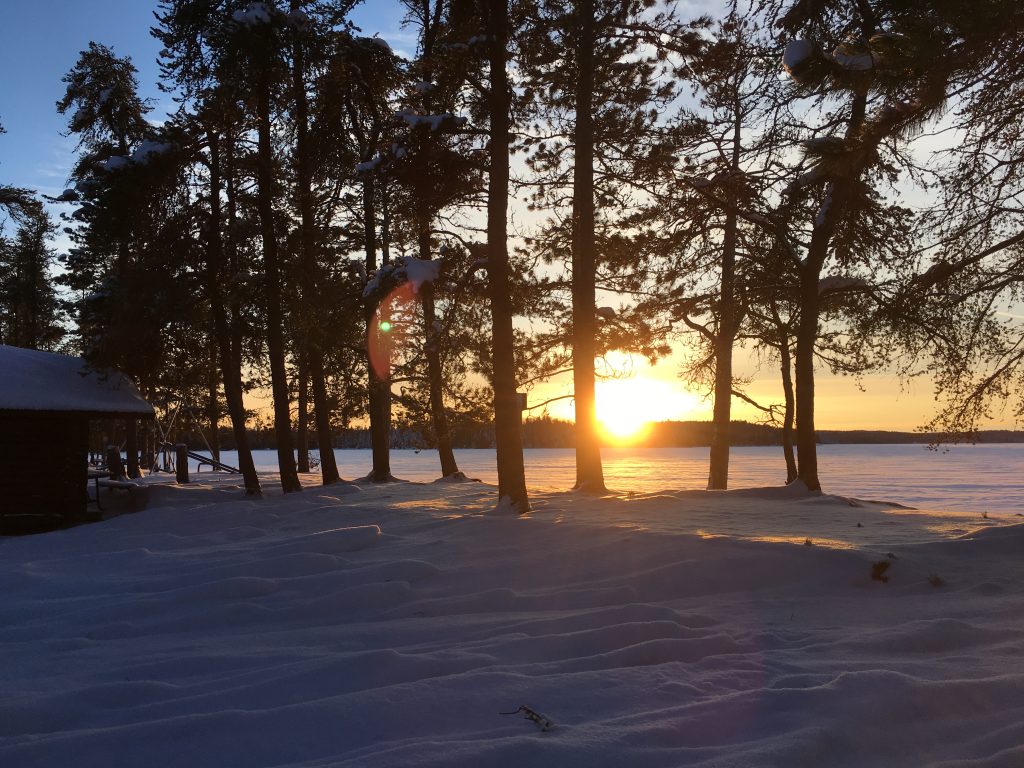
This year, for viewers at 45 degrees north, the latest sunrise occurs on January 2, when the sun will rise around 7:58 am. The Earth just passed its closest point to the sun, known as perihelion, a few days later on January 4.
Our place on the Earth, in the Northern Hemisphere, receives less sunlight in the winter because of the Earth’s tilt. So even though the Earth is closer to the sun, our temperature drops in the north are related to that tilt rather than to the Earth’s distance to the sun; learn more about equinoxes and solstices in this post.
Sunrise and sunset times:
| January 1 | January 15 | January 31 | |
| Sunrise | 8:07 am | 8:03 am | 7:49 am |
| Midday | 12:29 pm | 12:35 pm | 12:39 pm |
| Sunset | 4:51 pm | 5:07 pm | 5:30 pm |
The moon
The moon has long captivated observers of all ages. Even a pair of small binoculars will reveal the craters of the moon.
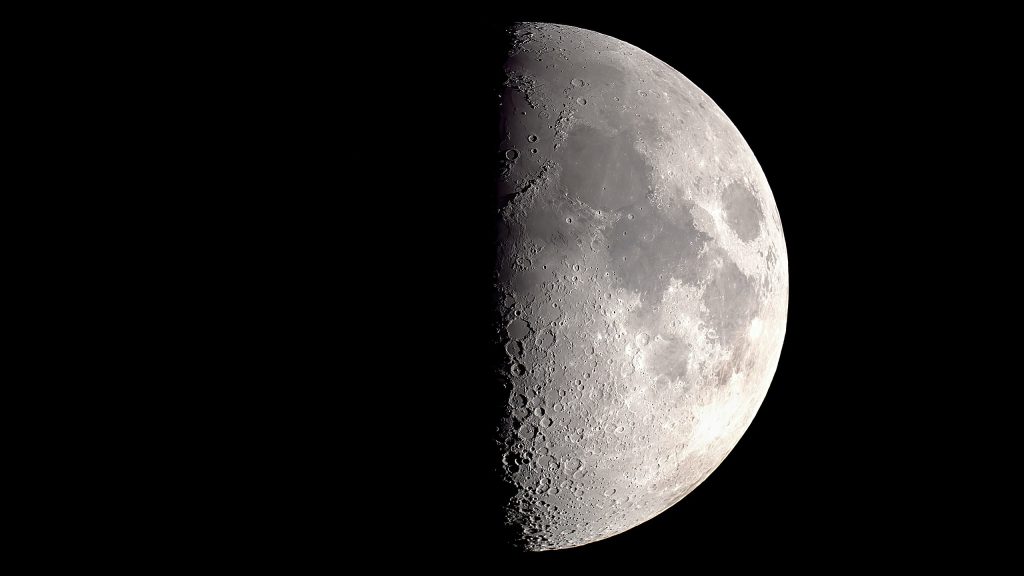
January’s lunar phases of the moon occur as follows:
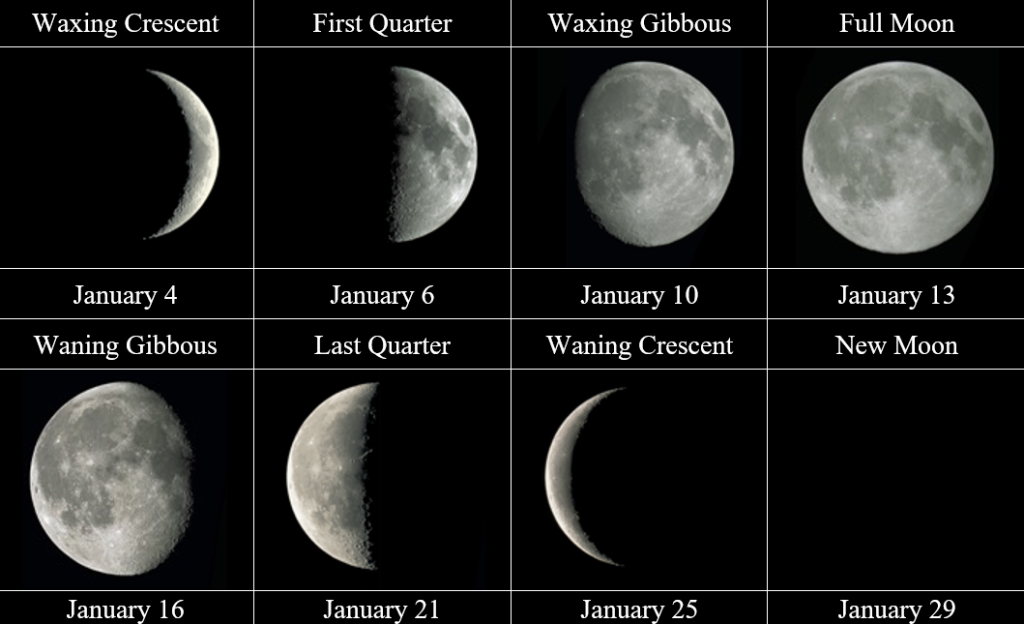
- January 4 – Waxing Crescent
- January 6 – First Quarter
- January 10 – Waxing Gibbous
- January 13 – Full Moon
- January 16 – Waning Gibbous
- January 21 – Last Quarter
- January 25 – Waning Crescent
- January 29 – New Moon
The planets
Venus
After making itself known as that very bright starlike object in the southwest at sunset, Venus continues to be seen shortly after the sun sets. However, because the path of the ecliptic – the apparent path that the Sun, Moon, and most of the planets appear to follow – is almost parallel to the southwestern horizon, Venus does not travel very far from the horizon throughout January.
It is a beautiful sight that is often mistaken for an airplane until you notice its lack of movement.
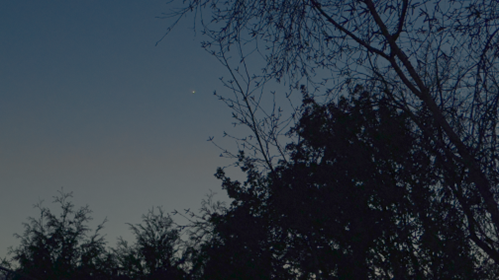
If you happen to be able to look at Venus with a powerful telescope, you’ll be astounded to discover – as Galileo did over 400 years ago – that Venus, as well as the planet Mercury, go through phases.
In January, Venus is in a “half-moon” phase (see the first quarter moon phase in the calendar above). However, Venus looks its best when it’s in the crescent phase which will be most visible for us in February.
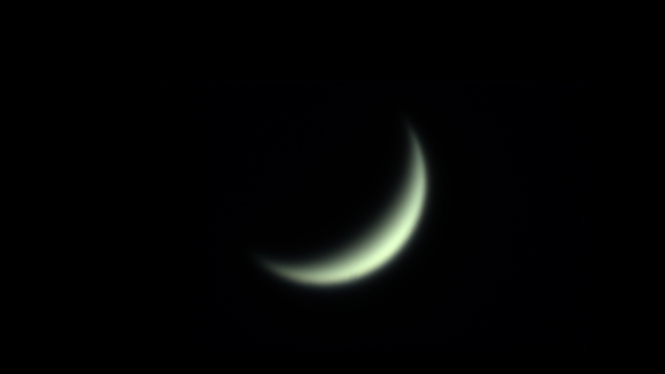
Saturn
Saturn rises before sunset, then is due south around sunset, and sets around 9:00 pm. Saturn is a spectacular object to observe in even the smallest telescope because of its prominent rings.
While for most of this year Saturn’s rings were difficult to see, the planet’s orbit and its inclination to the Sun are finally providing us with better views of the rings. The tilt of the rings will increase until it they look more like the image below.
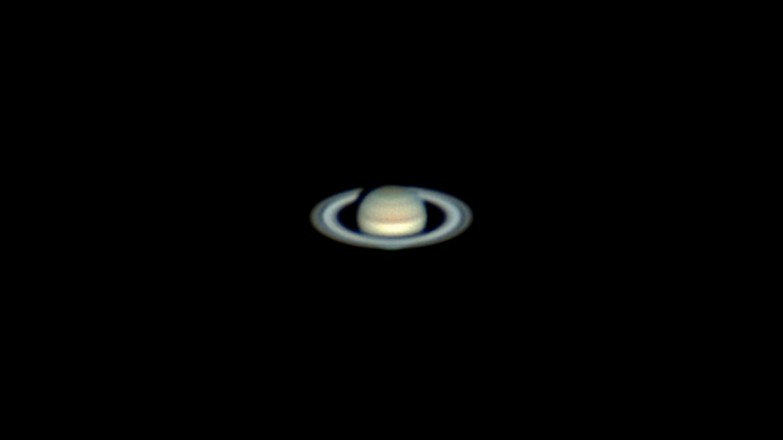
Jupiter
Jupiter is an incredible sight to see. Shining at a brilliant magnitude of -2.8 (the more negative the magnitude, the brighter it is), Jupiter is almost as bright as Venus!
Jupiter rises at sunset, crosses due south around midnight, and sets at sunrise.
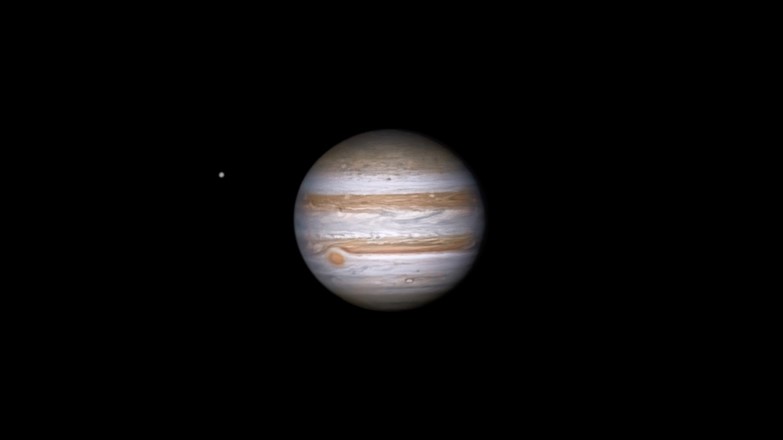
You can even see Jupiter during the daytime. To accomplish this feat, you need clear skies and patience. Simply follow Jupiter with your eyes in the early morning sky (about 30 minutes before sunrise). Then, when Jupiter is near the horizon and the Sun has risen, you should be able to see it.
Note: you will have to do this at the very beginning of the month. Jupiter passed through opposition on December 7, 2024 and is starting to fade as the Earth moves further away from it.
Jupiter is the largest planet in our solar system, larger than all of the other planets combined. In spite of its tremendous size, Jupiter rotates rapidly in just under 10 hours! This rapid rotation and the incredible chemistry of its gaseous atmosphere swirl Jupiter’s clouds into beautiful patterns.
One of Jupiter’s most distinctive features is its “Great Red Spot” (scientists are very colourful in their naming). This spot is about 2.5 times bigger than Earth and is an anticyclonic disturbance, which is the opposite of a hurricane because it is centered on a region of high pressure. In the timelapse image below, the motion of Jupiter can be seen over a 30-minute period.
While our imagery has displayed Europa and Io, the two largest of Jupiter’s known moons, we know of at least 91 others. which brings the number of Jupiter’s moons to a total of 95!
Mars
Mars follows Jupiter into the night sky a couple of hours later. It will grow in brightness and peak during its opposition on January 16, 2025.
Mars is an amazing planet to view! It looks reddish to our eyes because of its ever-present dust. The dust is largely composed of hematite, similar to rust. Because of its bloodred colour, it was given the name Ares by the Greeks, for their god of war, and, ultimately, Mars, for the Roman god of war.
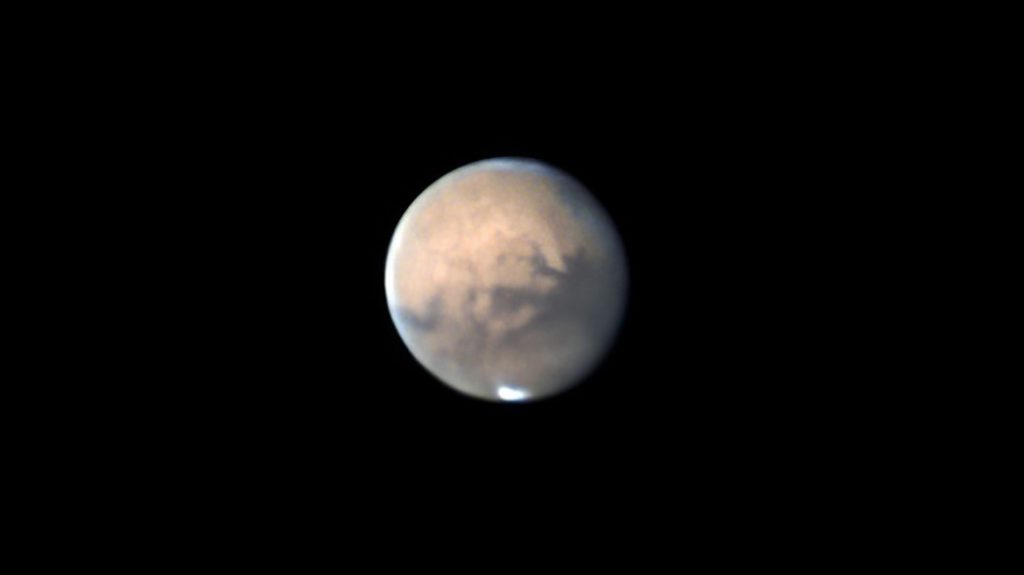
Mars continues to fascinate us with its incredibly rich and diverse geology. It also tantalizes us with the possibility of the existence of life.
Canada is an active participate in the study and exploration of Mars, and many scientists in Ontario have contributed to or are contributing to the exploration and understanding of this amazing planet!
Learn more about this martial planet in our previous post.
Meteor showers
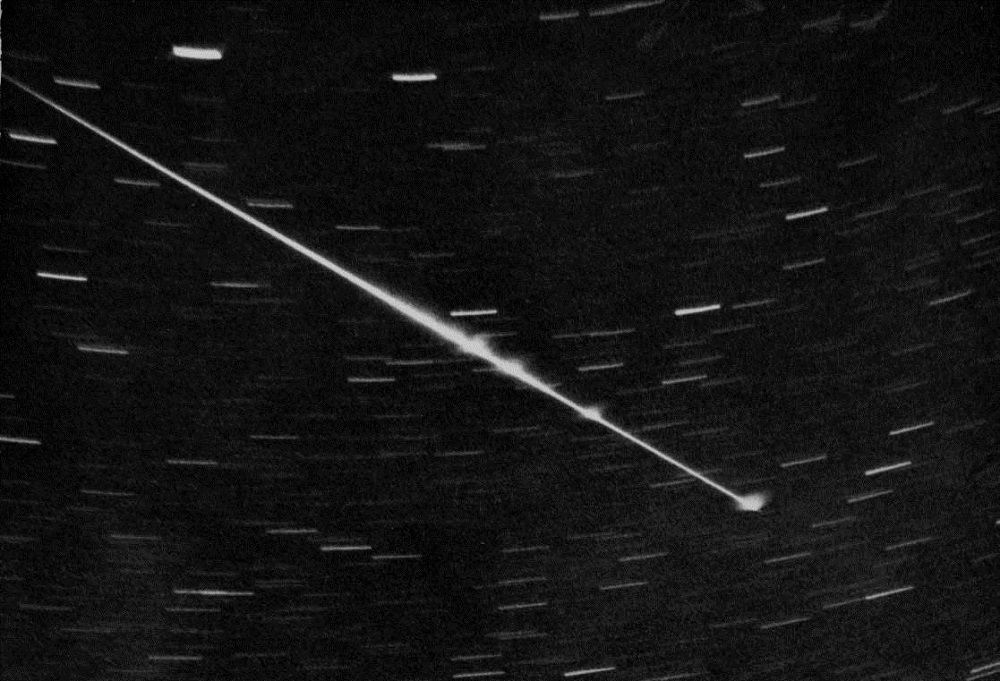
A meteor shower occurs when Earth enters the debris field of a comet that passed around the Sun long ago.
These bits of dust and grit – often no bigger than your thumbnail – enter the earth’s atmosphere and burn up high above the ground.
Meteor observing, especially in the dark skies of provincial parks, is one of the most enjoyable ways to get into astronomy.
You don’t need any special equipment other than your eyes, but a lounge chair, sleeping bag, and a friend are all welcome additions to wintertime stargazing. You can also practice learning your constellations while you watch for the meteors by using a constellation chart.
January has one meteor shower – the Quadrantids – but it sure is a beaut!
Viewers who brave the cold can see at least 25 meteors/hour, but the shower can often display closer to 100 meteors/hour in dark skies.
The shower will peak between 1:00 am and 5:00 am, perfect timing as the first quarter moon will have nearly set by then.
The author of this blog, Bruce Waters, has seen this meteor shower from Mew Lake Campground in Algonquin Provincial Park, in -35ºC temperatures.
Despite the cold, this meteor shower can warm the heart!
Featured constellations: Orion, Taurus, and Canis Major
For thousands of years, humans have looked up at the stars. The stars helped them try to understand their purpose, and the role stars play in our lives.
To help memorize the different stars, patterns of connect-the-dot figures were created by many different cultures. Today, we recognize 88 official patterns or “constellations” of stars.
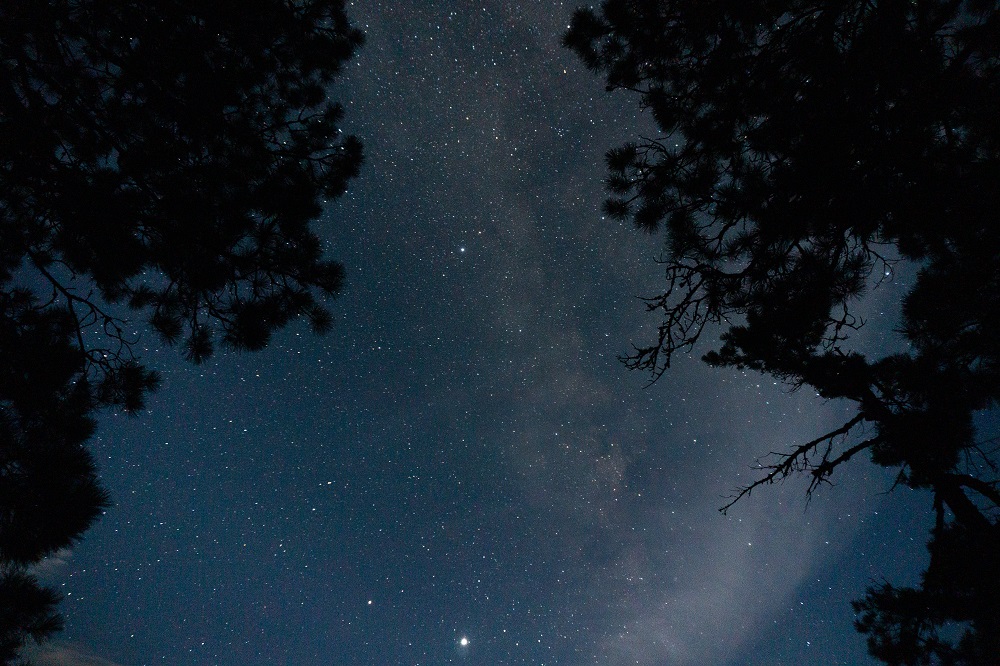
In this post we will explore three of those constellations: Orion the Hunter, Taurus the Bull, and Canis Major the Large Dog.
Orion is the great and boastful hunter of Greek Mythology. Orion is accompanied by his hunting dogs (Canis Major and Canis Minor) and is doing battle against Taurus the Bull.
Most people recognize the straight line of three stars making up the Belt of Orion.
The middle star of Orion’s belt (Alnilam) appears the same brightness as the other two belt stars. However, in reality, it is two times further away than both the left-most belt star Alnitak, and Betelgeuse, the red star marking one of Orion’s shoulders.
Underneath Orion’s belt is his sword. The middle object within the sword is a fuzzy, nebulous object that, when magnified, appears as a glowing gas cloud (easy to see in binoculars from provincial park skies).
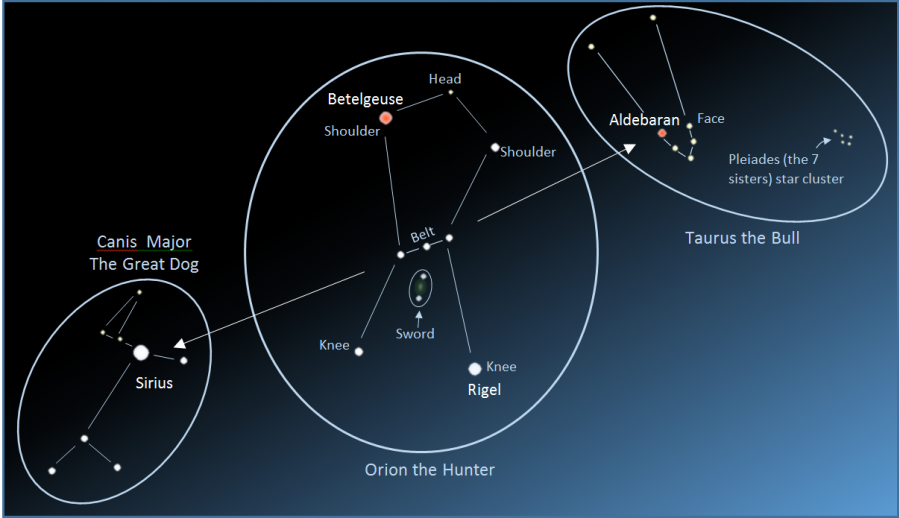
To find Canis Major, follow the belt of Orion down towards Sirius, the brightest star in the night sky. A collection of medium bright stars flowing down and to the left marks out the body of the great dog.
If one follows the belt stars to the upper right, they will find the reddish star Aldebaran which, with a collection of faint stars, forms a “V.” The “V” represents the face of the bull (Aldebaran is the eye), and there are two stars above the face forming Taurus’ horns.
Towards the back of Taurus, one can find a cluster of stars known as the Pleiades. This cluster, also known as the “Seven Sisters,” is not a formal constellation. However, it is often mistaken for the little dipper.
Did you know…
The calendar has astronomical origins.
While the constellations were, largely, created to help people remember significant star patterns, they have plenty of other uses. One of these is for the formation of the calendar.
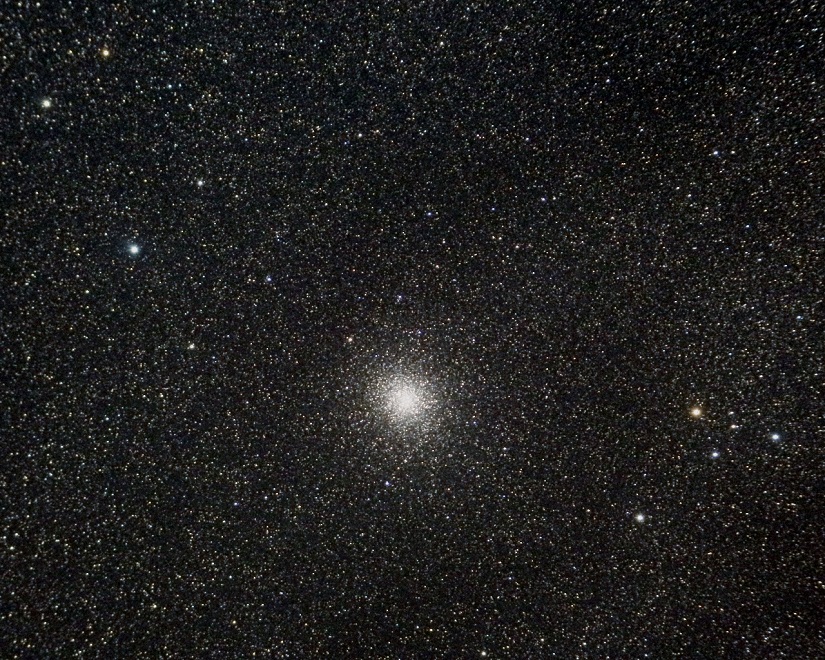
For example, the ancient Egyptians watched out for the star Sopdet, which is known as Sirius in Canada today. They knew that each year, when they would spot Sopdet rising, the annual Nile floods would soon be upon them.
Want to learn more? Visit our blog post about how the calendar came to be.
That completes January’s ode to the night skies
Check back each month as we highlight celestial events through the seasons or read more about astronomy in provincial parks.


